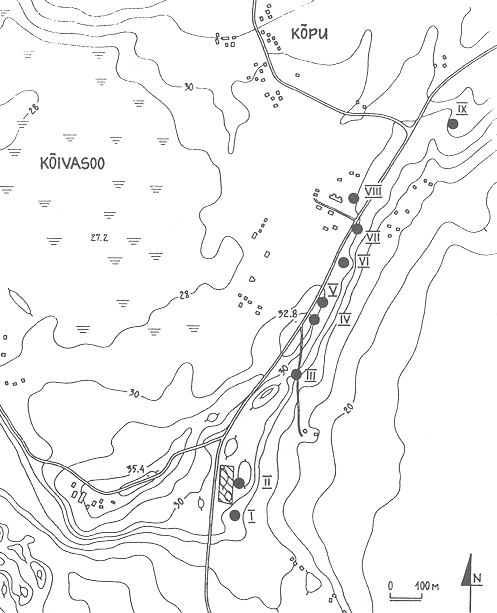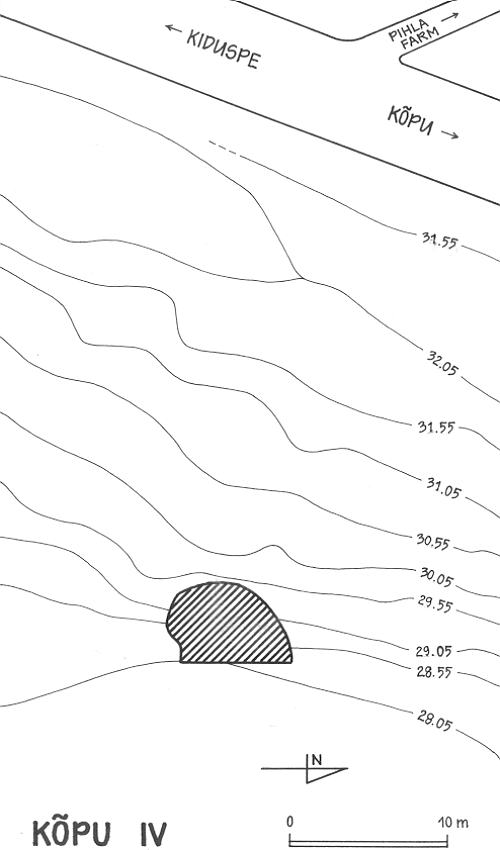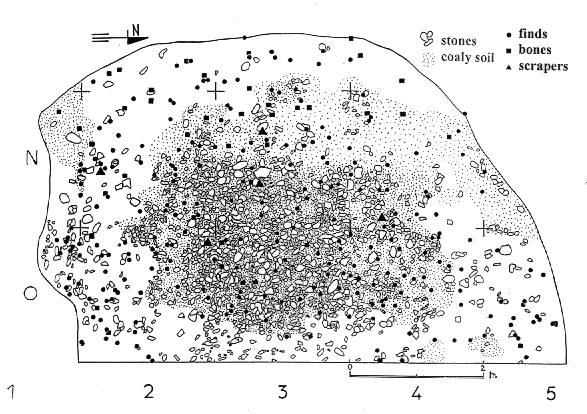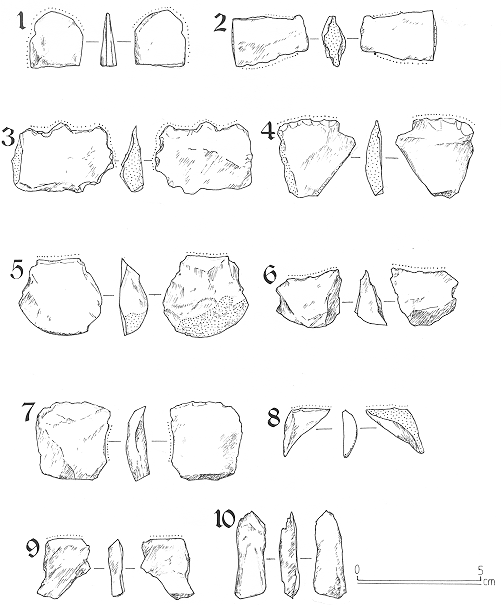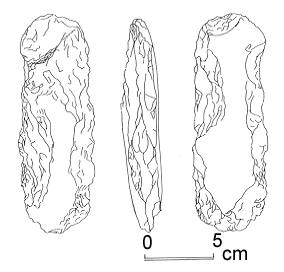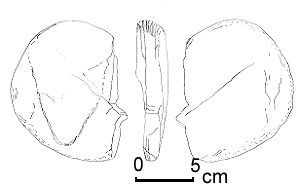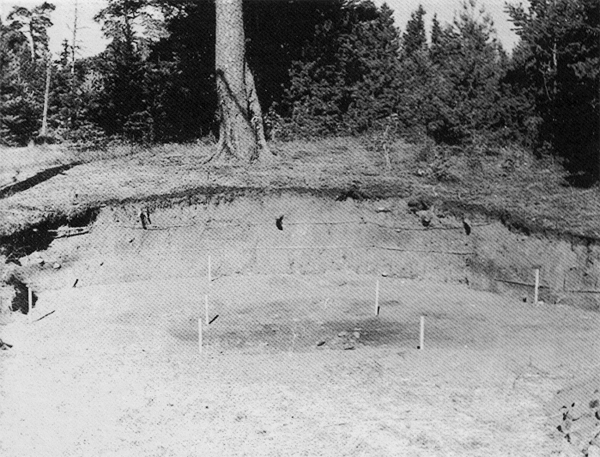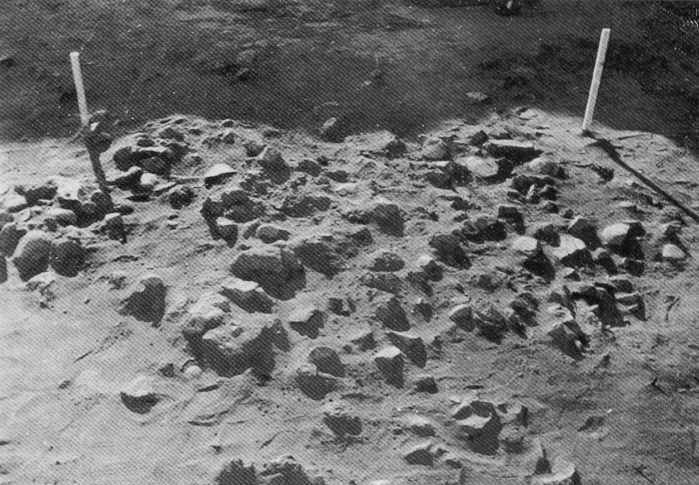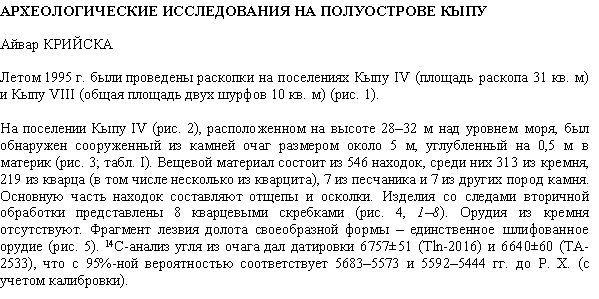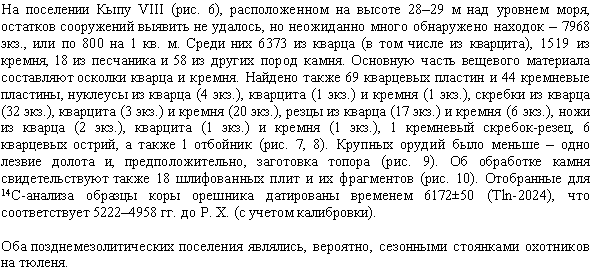|
ARCHAEOLOGICAL STUDIES ON THE KÕPU PENINSULA 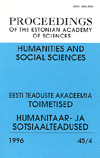
Aivar KRIISKA Tartu Ülikool
(University of Tartu). Lossi 3, EE-2400 Tartu, Eesti (Estonia).
Published: Proceedings of the Estonian Academy of Sciences. Humanities
and Social Sciences, 45:4, 1996, 398-409.
During the landscape survey carried
out on the Kõpu Peninsula in Hiiumaa in 1994, several new Stone
Age sites were found in the coastal formations of the Litorina Sea and
the Ancylus Lake. The artefacts found there suggested that some of the
sites might be even earlier than the first examined Early Neolithic Site
(Kõpu I), belonging probably to the Late Mesolithic period (Kriiska,
1995a). This hypothesis gave reason for a new archaeological expedition.
In 1995 excavations were carried
out in two settlement sites: Kõpu IV and VIII. Also the landscape
survey on ancient coastal formations was continued (Kriiska, 1995b). The
work was financed by PACT, the Estonian Science Foundation (grant to Lembi
Lõugas), and the newspaper Maaleht. KÕPU IV SITE The Kõpu IV site is situated
650 m north-east from the site I at Kiduspe–Kõpu Road, a score of
metres from the road leading to the village of Ülendi (Fig. 1). This
site has quite an extraordinary position. Namely, the cultural layer lies
on a rather steep ancient coastal formation 28–32 m a.s.l. (Fig. 2; Plate
I, 1). The lower part of the site was excavated. Subfossil molluscs
gathered in the immediate vicinity of the site represent typical fauna
of Ancylus Lake (Tavast, 1995, p. 12).
The excavations were simultaneously
of conservational purpose as the cultural layer had been damaged due to
quarrying sand. This purpose determined also the form and size of the excavation
area (Figs. 2, 3). The total area under investigation was 31 m2. The whole
surface was hand-screened.
In 1994 the complex of stones and
the coal surface were investigated in the centre of the ruined area. The
findings indicated that there had been a fire pit. It turned out to be
surprisingly well preserved and big (maximum size c. 5 x 5 m), embracing
the whole central part of the excavation area (Fig. 3; Plate I, 1). The
fire pit had been deepened unevenly into the ground. It was up to 0.5 m
deep and consisted of eight stone layers. There was a dark coaly soil and
much decomposed stone rubble between the stones. The stones in the fire
pit were mainly 10–15 cm in diameter, the biggest ones 30 cm (Fig. 3, Plate
I, 2). Coaly spots could be seen also outside the fire pit. At least two
of them could have formed separate fire pits.
The artefacts were situated inside
and outside the fire pit, more often on its edges (Fig. 3). In the excavation
area, the layer comprising the finds was 30–35 cm deep. Outside the fire
pit the artefacts were located in a rather dirty sandy surface. The excavation
profile shows that such a dirty sandy surface with some coaly places comprising
finds can be as thick as 1–1.2 m. It is possible that the top part has
been flushed down from the bank.
During the excavation in 1995 and
the investigation in 1994, 546 artefacts were disinterred1, 313 of them (57.3%) were of flintstone and 219 (40.1%) of
quartz (including
some of quartzite), 7 (1.3%) of sandstone, and 7 of other rocks (biotite
gneiss, leptite, granite fegmatite, quartz-feldspar-gneiss) (Tables 1,
2).2 Flakes make up the majority
of the flintstone finds. Only seven blades were found and the artefacts
showing secondary processing were totally missing among the flintstone
finds.
Flakes without secondary processing
(94.5%), a blade-like flake included, predominate among the quartz finds.
There are only two quartz blades (0.9% of all quartz artefacts) (Fig. 4,
10)
and in one case it is probably a core. As to the artefacts of secondary
processing, mainly scrapers (Fig. 4, 1–8) and a knife (Fig. 4, 9)
were found. Burins are entirely missing. There are seven side scrapers
and one end scraper among the eight scrapers found there (3.7% of the quartz
finds). They have been made of a blade-like flake (5) or a flake (3). In
shape they are triangular (2), irregular (2), segmental (1), trapezial
(1), rectangular (1), or square (1). One scraper has two edges. Edges are
mainly narrow (6), convex and less than 2 cm wide (4), straight (3), concave
(1), or even wavy (1).
Only one polished stone artefact
was found – part of the edge of a quartz-feldspar-gneiss chisel of quite
an extraordinary shape (Fig. 5). Seven polish stones or their fragments
were found.
The charcoal found at the fire pit
was radiocarbon dated to 6757±51 BP (Tln-2016), which corresponds with
95% of probability to 5683–5573 BC (cal.). Another charcoal test from the
fire pit 14C dates to 6640±60 (TA-2533),
corresponding to 5592–5444 BC (cal.). The coal gathered in the whole excavation
area and round the fire pit, gave a younger date. However, this may be
caused by coal pieces originating from burnings after the cultural layer
was formed in the test. 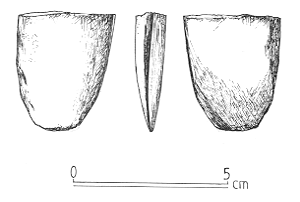
Fig. 5. Chisel from the Kõpu IV site (AI 6054:213) KÕPU VIII SITE The site is situated 400 m north-east from site IV near the schoolhouse of Kõpu (Fig. 1). The cultural layer is on the coastal formation that is 28–29 m a.s.l. (Fig. 6). A small test excavation of 3 m2 had been started already in 1994, in the summer of 1995 it was finished and in addition a trench of 7 m2 was excavated. The whole surface was hand-screened. No constructions were found in site VIII although test holes were made to look for their existence. However, the area was very rich in finds. In both test excavations the finds were got from a half-metre-thick sand layer, the upper 20–30 cm of which was sodded and podzolized. The amount of find material decreased in the lower parts of the layer. The total sum of artefacts was 7968, that is nearly 800 finds per 1 m2.3 Of these 6373 (80%) are quartz (a smaller part quartzite)4, 1519 (19.1%) are flintstone, 18 (0.2%) sandstone and 58 (0.7%) other rocks (quartz-feldspar-gneiss, granite-fegmatite, leptite, diabase, granite, gabro, amfibo legneiss etc.) (Tables 1, 2). The main part of the finds consists
of quartz- and flintstone flakes without secondary processing (Fig. 7,
10)
and fen lumps. Also 69 quartz (1.1% of all quartz finds) and 44 flintstone
blades (2.9% of flint) were found (Fig. 7, 4, 5, 7–9). The length
of quartz blades is 0.9–4.8 cm, 59.4% of them are less than 2.5 cm long.
The width is 0.4–2.4 cm; 60.9% being up to 1.1 cm wide. One ridge occurs
in case of 45 blades, 21 blades are without ridges, and 3 have two ridges.
Flintstone blades are 0.8–4.7 cm long, with 65.9% shorter than 2 cm. The
width is 0.4–2.0 cm, a quarter being 0.5 cm wide. Thirty-three of the blades
have one ridge, five have two-ridges, and six are without ridges. Blade-like
flakes number 143, 72 of them are of quartz (1.1% of quartz) and 71 of
flintstone (4.7% of flint).
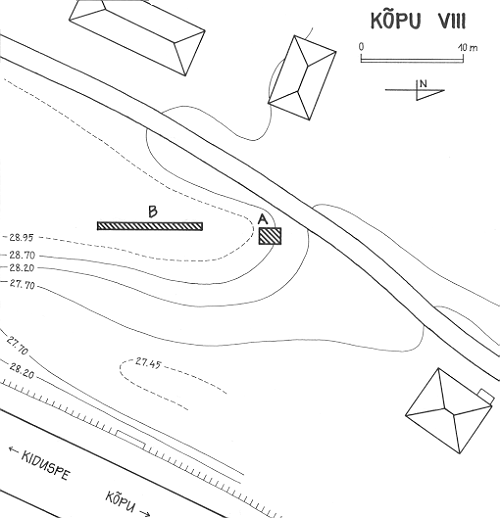
Fig. 6. The plan of the Kõpu VIII site Table
1
Table
2
A total of six cores were obtained,
four from quartz (Fig. 8, 2), one from quartzite (0.08% of quartz),
and one from flintstone (0.07% of flintstone).
The number of small tools of
secondary
processing was 83 (1.0% of all the finds). Most of them were scrapers,
altogether 55 (66.3% of the small artefacts of secondary processing). Thirty-two
scrapers are made of quartz, three of quartzite (0.5% of quartz finds),
and twenty of flintstone (1.3% of flintstone). Side scrapers number 26
(15 of quartz and 11 of flint) (Fig. 7, 3; Fig. 8, 5, 6),
21 (14 of quartz, 2 of quartzite and 5 of flint) are end scrapers (Fig.
7, 1, 2; Fig. 8, 1) and 8 (3 of quartz, 1 of quartzite, and
4 of flint) are end-side scrapers. They are made of flake (27 of quartz,
3 of quartzite, and 13 of flint), blade-like flake (5 of quartz and 5 of
flint), or blade (2 of flint). Scrapers are of trapezial shape (11 of quartz,
1 of quartzite, 7 of flint), triangular (3 of quartz, 1 of quartzite, 11
of flint), oval (6 of quartz, 1 of flint), five-cornered (among them are
5 quartz scrapers of regular form, while 2 of quartz and 1 of quartzite
are irregular), rectangular (2 of quartz) and square (1 of quartz), or
of irregular form (2 of quartz, 1 of flint). Scrapers are mainly with a
narrow edge. Five flintstone scrapers have two edges and one has even four
edges. Seven quartz and quartzite scrapers have two edges. For the most
part (7) the scrapers with several edges have one edge at the end, two
edges at the side; 2 flintstone and 2 quartz scrapers have two side edges
(one flintstone scraper has two edges even on one side) and one quartz
scraper has two end edges. The edges of 17 quartz, 3 quartzite, and 7 flintstone
scrapers are convex; 15 quartz and 6 flintstone scrapers have straight
edges; 4 quartz, 1 quartzite and 5 flintstone scarpers have concave edges;
and 2 quartz and 10 flintstone scarpers have wavy edges. Flintstone scrapers
do not measure more than 3.5 cm, but one of them is even a microscaper.
Quartz and quartzite scrapers are usually bigger, their length is between
2.5 and 4.5 cm. 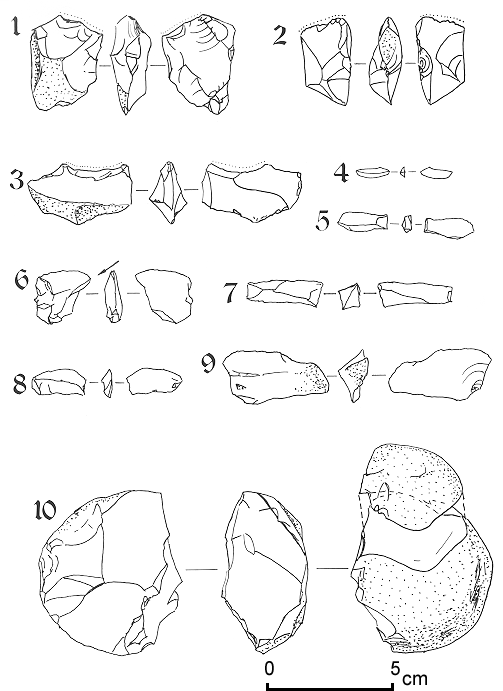
Fig. 7. Flintstone scrapers (1–3), chips (4, 5, 7–9), a burin (6), and a flake (10) from the Kõpu VIII site (AI 6054:141, 114, 109, 150, 49, 98, 74, 126, 148, 109). Burins found numbered 23 (27.7% of smaller artefacts), 17 of them are of quartz (0.3% of the quartz finds) and 6 of flint (0.4% of flint finds). Corner edges occur in case of 12 quartz and flintstone burins (Fig. 7, 6; Fig. 8, 3) and 5 quartz and flintstone burins have an edge in the middle (Fig. 8, 6). Burins are made of flake (14 of quartz and 5 of flint), blade-like flake (2 of quartz and 1 of flint), and blade (1 of quartz). They are triangular (8 quartz and 5 flint burins), trapezial (6 quartz), oval (1 quartz and 1 flint), rectangular (1 quartz), and irregular (1 quartz) in shape. Quartz burins are 1.5–5.1 cm long, mostly 2.5–3.5 cm. Flintstone burins are 2.0–3.9 cm long. 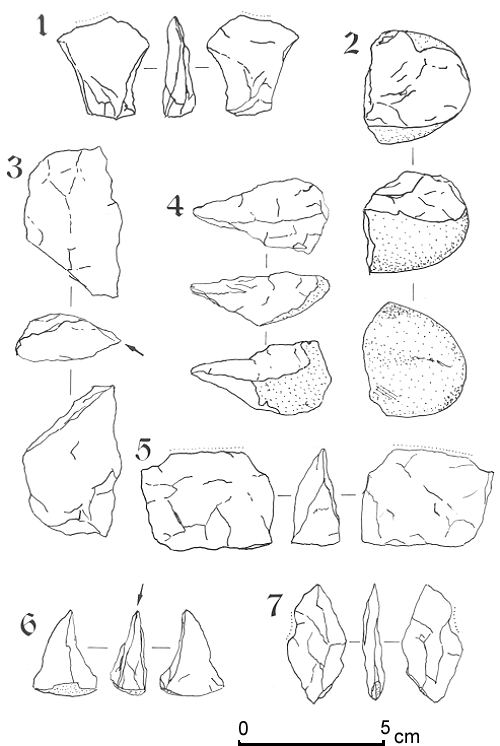
Fig. 8. Quartz scrapers (1, 5, 7), cores (2), burins (3, 6), and a point (4) from the Kõpu VIII site (AI 6021:36, 59, 46, 33, 29, 108, 96) Four artefacts classified as knives
were found (4.8% of the smaller finds), two of them are of quartz, one
is of quartzite (0.05% of quartz finds), and one of flintstone (0.07% of
flintstone finds). They have been made of blade-like flake except one that
is a quartz knife made of flake. Their shape is trapezial, one quartzite
knife is five-cornered. The edges are broad (more than 2.5 cm) and mainly
slating, the edge of flint knife retouched.
Among polyfunctional tools one flint
scraper-burin was disinterred. Both its parts have side edges, in the scraper
part it is broad and convex.
Among functional tools (that is finds
without special processing) six quartz points (0.1% of the quartz finds)
could be distinguished (Fig. 8, 4). They all have been made of flake
and they are triangular. Points are 2.6–7.0 cm long. One quartz striking
stone was also found.
The number of big stone artefacts
found was small. In addition to four undetermined stones with polished
surface a biotite-gneiss well-polished wedge edge and an axe-blank of gabro
oblong pebble (Fig. 9) were found. Eightteen sandstone polish stones (Fig.
10) or their fragments indicate to stone polishing. The sandstone is mainly
Orduvician.
From this site 2031 hazelnut shells
(total weight 64.6 g) were gathered. The 14C date of
these nutshells is 6172±50 BP (Tln-2024), which corresponds to 5222–4958
BC (cal.). An attempt was made to date also the coal got at the site Kõpu
VIII; however, this yielded improbably young ages. As the cultural layer
was located directly on the ground and it was usually covered with a thin
sod layer, it is possible marks of later fire making occurred there.
Find material and the datings suggest
that the first inhabitants came to Kõpu Island already in the Late
Mesolithic. Traces of settlement on the coastal formation of the Ancylus
Lake date probably from the maximum water level of the Litorina Sea. The
whole settlement has been closely connected with the sea: people followed
the transgressing water. The results of the excavations made in 1995 refer
also to seasonal settlement, probably the area was frequented by seal hunters
(Kriiska, 1995a; Moora & Lõugas, 1995). The bulk of the scanty
osteological material consists of bones of ringed seal.5 ________
PLATE I
REFERENCES Kriiska, A.
1995a. Archäologische Ausgrabungen auf dem Standort der ehemalige
Steinzeitsiedlung Kõpu I (Ristipõllu). — Proc. Estonian Acad.
Sci. Humanities and Social Sciences, 44, 4, 410–416.
Kriiska, A. 1995b. Aruanne arheoloogilisest inspektsioonist ja
kaevamistest Kõpu “Ristipõllu” kiviaja asulakohal. Manuscript in the
Institute of History, Tallinn.
Moora, H. & Lõugas, L. 1995. Natural conditions at
the time of primary habitation of Hiiumaa Island. — Proc. Estonian Acad. Sci.
Humanities and Social Sciences, 44, 4, 472–481.
Tavast, E. 1995. Subfossiilsed molluskid Hiiumaa vanades
rannavetes. — In: XVIII Eesti loodusuurijate
päev. Hiiumaa loodus. 22.–23. juuli 1995 Hiiumaa, Kuri. Tartu–Tallinn,
12–17. ARHEOLOOGISED UURIMISTÖÖD KÕPU POOLSAAREL Aivar KRIISKA 1995. aastal jätkusid
väljakaevamised
Hiiumaal Kõpu poolsaarel. Kaevandid rajati Kõpu IV (31 m²)
ja Kõpu VIII asulakohale (kahe proovikaevandi kogupindala 10 m²;
joon. 1).
28–32 m üle merepinna
paikneval
IV asulakohal (joon. 2) kaevati välja u. poole meetri sügavuselt
maapinda süvendatud ca 5 m läbimõõduga kivikolle
(joon 3, tahv. I). Kokku saadi 546 leidu, neist 313 tulekivist ja 219
kvartsist (sh. üksikud kvartsiidist), 7 liivakivist ja 7 teistest
kivimitest. Suurema osa leidudest moodustasid killud. Teisase töötlusega
esemetest saadi kaheksa kvartskõõvitsat (joon. 4, 1–8,)
täiesti puudusid tulekiviesemed. Ainsaks lihvitud kiviesemeks oli
omapärase kujuga talva teraosa (joon. 5). Tuleasemelt kogutud süsi
andis 14C-dateeringuks 6757±51 (Tln-2016),
mis 95-protsendise tõenäosusega vastab aastatele 5680–5570
e.Kr. (cal.), ja 6640±60 (TA-2533), mis 95-protsendise tõenäosusega
vastab aastatele 5592–5444 e.Kr. (cal.).
28–29 m üle merepinna paikneval
VIII asulakohal (joon. 6) mingeid konstruktsioone leida ei õnnestunud.
Siiski saadi üllatuslikult rohke leiuaines — igalt ruutmeetrilt u.
800 leidu. Kogutud 7968 leiust olid 6373 kvartsist (sh. vähene kvartsiit),
1519 tulekivist, 18 liivakivist ja 58 muudest kivimitest. Leidude põhiosa
olid kvartsi- ja tulekivikillud. Leiti 69 kvarts- ja 44 tulekivilaastu;
4 kvartsist, 1 kvartsiidist ja 1 tulekivist nukleus; 32 kvarts-, 3 kvartsiit-
ja 20 tulekivikõõvitsat; 17 kvarts- ja 6 tulekiviuuritsat;
2 kvarts-, 1 kvartsiit- ja 1 tulekivinuga; 1 tulekivist kõõvitsuurits,
6 kvartsteravikku ning 1 löögikivi (joon. 7, 8). Suuri
kiviesemeid leiti vähe, mõne kivieseme fragmendi kõrval
oli vaid üks talva teraosa ja arvatav kivikirve toorik (joon. 9) Kivilihvimisele
osutavad ka 18 lihvimiskivi või nende fragmenti (joon. 10). Asulakohalt
kogutud sarapuupähkli koortest tehtud 14C-dateering
andis vanuseks 6172±50 (Tln-2024), mis vastab aastatele 5222–4958 e.Kr.
(cal.).
Mõlemad hilismesoliitilised
asulakohad tekkisid oletatavasti hülgeküttide hooajaliste peatuspaikadena. |
|||||||||||||||||||||||||||||||||||||||||||||||||||||||||||||||||||||||||||||||||||||||||||||||||||||||||||||||||||||||||||||||||||||||||||||||||||||||||||||||||||||||
